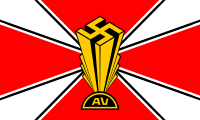Jerman Amerika Bund
| German American Bund | |
|---|---|
| Amerikadeutscher Volksbund | |
 Bendera Jerman Amerika Bund | |
| Nama lain | "German American Federation" |
| Pemimpin | Fritz Julius Kuhn |
| Pendirian | 1936 |
| Pembubaran | 1941 |
| Negara | United States |
| Wilayah operasi | Seluruh Amerika Serikat, terutama New York,[1] Pennsylvania, New Jersey, dan Midwest |
| Ideologi | Nazisme Jermanisasi Pan-Jermanisme Anti-Semitisme Non-intervensionisme[2] |
| Posisi politik | Kanan jauh |
| Jenis serangan | |
| Status | Mati |
| Jumlah anggota | 25.000[3] |
Jerman Amerika Bund (German American Bund atau German American Federation;bahasa Jerman: Amerikadeutscher Bund; Amerikadeutscher Volksbund, AV) adalah organisasi pro-nazi di AS antara 1936-41, mencapai hingga 25.000 anggota. Organisasi ini terdiri dari warga negara amerika dengan keturunan Jerman, memiliki sekitar 20 kamp pemuda dan pelatihan gabungan, dan 70 divisi regional di seluruh negeri Amerika Serikat. Pada tahun 1939 mereka menggelar unjuk rasa di Madison Square Garden, dengan lebih dari 20.000 pendukung hadir.[4] Ketika perang pecah pada tahun 1939, organisasi mulai berantakan, pemimpinnya, Fritz Julius Kuhn ditangkap karena penggelapan dan setelah perang dideportasi ke Jerman.[5] Beberapa anggota Bund dilaporkan menyatakan George Washington sebagai Fasis pertama karena mereka mengklaim bahwa, dia (Washington) pun tahu kalau demokrasi tidak bisa berfungsi.[6]
Referensi
[sunting | sunting sumber]- ^ Federal Bureau of Investigation. "German American Federation/Bund Part 11 of 11". FBI Records: The Vault.
- ^ "American Nazi organization rally at Madison Square Garden, 1939". Rare Historical Photos. February 19, 2014.
- ^ "German American Bund". Holocaust Encyclopedia. July 2, 2016.
- ^ "Bund Activities Widespread. Evidence Taken by Dies Committee Throws Light on Meaning of the Garden Rally". New York Times. February 26, 1939. Diakses tanggal 2015-02-19.
Disorders attendant upon Nazi rallies in New York and Los Angeles this week again focused attention upon the Nazi movement in the United States and inspired conjectures as to its strength and influence.
- ^ Jim Bredemus. "American Bund – The Failure of American Nazism: The German-American Bund's Attempt to Create an American "Fifth Column"". TRACES. Diarsipkan dari versi asli tanggal 2011-05-18. Diakses tanggal March 2, 2011.
- ^ American Nazis in the 1930s—The German American Bund
Bacaan lanjutan
[sunting | sunting sumber]- Allen, Joe, "'It Can't Happen Here?': Confronting the Fascist Threat in the US in the Late 1930s," International Socialist Review, Part One: whole no. 85 (Sept.-Oct. 2012), pp. 26–35; Part Two: whole no. 87 (Jan.-Feb. 2013), pp. 19–28.
- Bell, Leland V. In Hitler's Shadow; The Anatomy of American Nazism, 1973
- Canedy, Susan. Americas Nazis: A Democratic Dilemma a History of the German American Bund Markgraf Pubns Group, 1990
- Diamond, Sander. The Nazi Movement in the United States: 1924–1941. Ithaca: Cornell University, 1974.
- Jenkins, Philip. Hoods and Shirts: The Extreme Right in Pennsylvania, 1925–1950 University of North Carolina Press, 1997
- MacDonnell, Francis. Insidious Foes: The Axis Fifth Column and the American Home Front Oxford University Press, 1995
- Miller, Marvin D. Wunderlich's Salute: The Interrelationship of the German-American Bund, Camp Siegfried, Yaphank, Long Island, and the Young Siegfrieds and Their Relationship with American and Nazi Institutions Malamud-Rose Publishers, November 1983(1st Edition)
- Norwood, Stephen H. "Marauding Youth and the Christian Front: Antisemitic Violence in Boston and New York during World War II" American Jewish History, Vol. 91, 2003
- Schneider, James C. Should America Go to War? The Debate over Foreign Policy in Chicago, 1939–1941 University of North Carolina Press, 1989
- St. George, Maximiliam and Dennis, Lawrence. A Trial on Trial: The Great Sedition Trial of 1944 National Civil Rights Committee, 1946
- Strong, Donald S. Organized Anti-Semitism in America: The Rise of Group Prejudice during the Decade 1930–40 1941
- Van Ells, Mark D. (August 2007). Americans for Hitler – The Bund. America in WWII. 3. hlm. 44–49. Diakses tanggal May 13, 2016.

